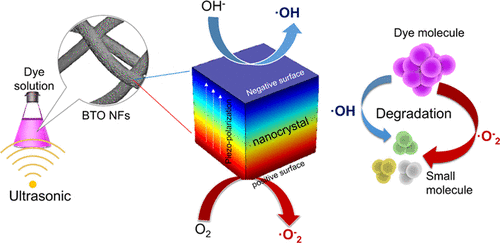当前位置:
X-MOL 学术
›
ACS Appl. Mater. Interfaces
›
论文详情
Our official English website, www.x-mol.net, welcomes your
feedback! (Note: you will need to create a separate account there.)
Synthesizing BaTiO3 Nanostructures to Explore Morphological Influence, Kinetics, and Mechanism of Piezocatalytic Dye Degradation
ACS Applied Materials & Interfaces ( IF 8.3 ) Pub Date : 2020-04-01 , DOI: 10.1021/acsami.9b23351 Daiming Liu 1, 2 , Chengchao Jin 3 , Fukai Shan 2 , Junjing He 3, 4 , Fei Wang 1
ACS Applied Materials & Interfaces ( IF 8.3 ) Pub Date : 2020-04-01 , DOI: 10.1021/acsami.9b23351 Daiming Liu 1, 2 , Chengchao Jin 3 , Fukai Shan 2 , Junjing He 3, 4 , Fei Wang 1
Affiliation

|
Piezocatalysts have attracted much attention due to their excellent degradation ability for organics. In this work, three types of BaTiO3 (BTO) nanostructures, including hydrothermally synthesized nanocubes (NCs), sol–gel calcined nanoparticles (NPs), and electrospun nanofibers (NFs), are prepared for catalyzing the dye degradation. Compared with the NCs and NPs, the NFs exhibit a higher piezocatalytic degradation performance due to the large specific surface area, fine crystal size, and easy deformation structure. Moreover, the kinetic factors, including initial dye concentration, ionic strength, ultrasonic power, and applied action, influencing the degradation performance of the BTO NFs are analyzed deeply. A high degradation rate constant of 0.0736 min–1 is achieved for rhodamine B, which is superior compared with the previous reports. The excellent stability of BTO NFs is demonstrated by the cycling tests, where a high degradation efficiency of 97.6% within 110 min is still obtained after the third cycle. Furthermore, the mechanism of piezocatalysis revealed that the hydroxyl and superoxide radicals are the main reactive species in the degradation process. This work is of importance for the development of high-performance piezocatalysts and highlights the potential of piezocatalysis for water remediation.
中文翻译:

合成BaTiO 3纳米结构以探索形态学影响,动力学和压电降解染料的机理
压电催化剂因其对有机物的出色降解能力而备受关注。在这项工作中,制备了三种类型的BaTiO 3(BTO)纳米结构,包括水热合成纳米立方体(NCs),溶胶-凝胶煅烧纳米颗粒(NPs)和电纺纳米纤维(NFs),以催化染料降解。与NCs和NPs相比,NFs由于具有大的比表面积,细小的晶体尺寸和易于变形的结构而具有更高的压电催化降解性能。此外,深入分析了影响BTO NFs降解性能的动力学因素,包括初始染料浓度,离子强度,超声功率和施加的作用。0.0736 min –1的高降解速率常数罗丹明B达到了最佳效果,与以前的报道相比更胜一筹。BTO NFs的优异稳定性通过循环测试证明,在第三次循环后,在110分钟内仍可获得97.6%的高降解效率。此外,压电催化的机理表明,羟基和超氧化物自由基是降解过程中的主要反应物种。这项工作对于高性能压电催化剂的开发具有重要意义,并突出了压电催化剂在水修复方面的潜力。
更新日期:2020-04-01
中文翻译:

合成BaTiO 3纳米结构以探索形态学影响,动力学和压电降解染料的机理
压电催化剂因其对有机物的出色降解能力而备受关注。在这项工作中,制备了三种类型的BaTiO 3(BTO)纳米结构,包括水热合成纳米立方体(NCs),溶胶-凝胶煅烧纳米颗粒(NPs)和电纺纳米纤维(NFs),以催化染料降解。与NCs和NPs相比,NFs由于具有大的比表面积,细小的晶体尺寸和易于变形的结构而具有更高的压电催化降解性能。此外,深入分析了影响BTO NFs降解性能的动力学因素,包括初始染料浓度,离子强度,超声功率和施加的作用。0.0736 min –1的高降解速率常数罗丹明B达到了最佳效果,与以前的报道相比更胜一筹。BTO NFs的优异稳定性通过循环测试证明,在第三次循环后,在110分钟内仍可获得97.6%的高降解效率。此外,压电催化的机理表明,羟基和超氧化物自由基是降解过程中的主要反应物种。这项工作对于高性能压电催化剂的开发具有重要意义,并突出了压电催化剂在水修复方面的潜力。











































 京公网安备 11010802027423号
京公网安备 11010802027423号